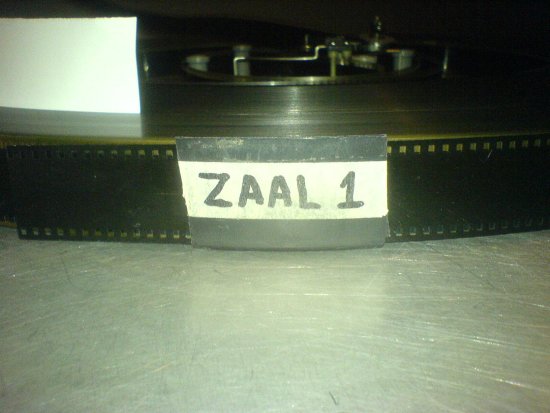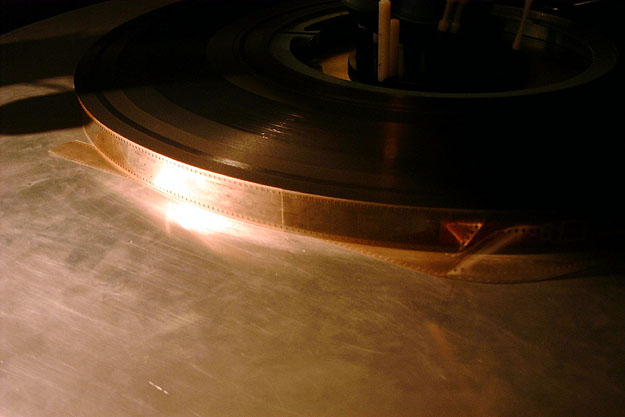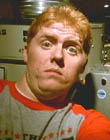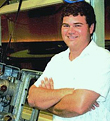|
|
This topic comprises 8 pages: 1 2 3 4 5 6 7 8
|
|
Author
|
Topic: Tips for Booth Operations
|
|
|
|
|
|
|
|
|
|
|
Monte L Fullmer
Film God

Posts: 8367
From: Nampa, Idaho, USA
Registered: Nov 2004
|
 posted 04-24-2007 01:20 AM
posted 04-24-2007 01:20 AM




..as long as the soundtrack is going in first on the tail tuck. For if the soundtrack is away by twisting the film in the opposite direction, the film has more possiblities of looping over the top of the filmroll on the platter.. and a deadly event occurs if such a mishap takes place.
OKEY ,gonna present another 'show and tell' here on how the majority of the cinemas in this part of the state tags their end of the prints ... doesn't cost anything (if you can snitch some clothpins from the laundry area, or spend a few pennies on some clothpins), no platter rings, no tucks, magnet platter stops, no hockey puks, - just a reliable method that holds the end together and never falters.
Pict-1 below showing the clothspin method of a filmroll wrap

Pict-2 Below showing the necessary "equipment" - about 10ft of scrap film and a clothspin. On larger prints, more longer scrap film.

Pict-3 showing how to attach the scrap film to the tail end with the clothspin.
.

Pict-4 Showing on winding the scrap film around the filmroll with the clothspin still attached to the end of the filmroll

Pict-5 Showing on removing the clothspin when the scrapfilm overlaps the area of the filmroll. Plus holding tight the end of the scrapfilm.

Pict-6 Showing after removal of the clothspin, to reinsert the clothspin where the end of the scrapfilm and the wrap of the scrapfilm meets. After clipping the clothspin in this area, give the end of the scrapfilm a tug to secure the scrapfilm around the filmroll.

Pict-7 Showing what's left on the platter when the film has been taken up on the rewind platter - a nice ring of scrapfilm with the clothspin securing it together.

(If Brad wants to move this to the "TIPS" section, be his choice.)
thx-Monte
| IP: Logged
|
|
|
|
|
|
|
|
|
|
|
|
|
|
|
|
|
|
Ken Lackner
Phenomenal Film Handler

Posts: 1907
From: Atlanta, GA, USA
Registered: Sep 2001
|
 posted 05-12-2007 07:10 PM
posted 05-12-2007 07:10 PM




Many companies maintain this policy, which is a very good idea. Yes, everything should always start in frame, in focus, etc. In a perfect world. But here's the deal. NO ONE is perfect. For that matter, no machine is perfect, either. The most skilled conscientious projectionist could still have a bad day and start one film out of frame. Or the platter may decide not to take up, or the lamp may not strike, or.... You see my point?
| IP: Logged
|
|
|
|
All times are Central (GMT -6:00)
|
This topic comprises 8 pages: 1 2 3 4 5 6 7 8
|
Powered by Infopop Corporation
UBB.classicTM
6.3.1.2
The Film-Tech Forums are designed for various members related to the cinema industry to express their opinions, viewpoints and testimonials on various products, services and events based upon speculation, personal knowledge and factual information through use, therefore all views represented here allow no liability upon the publishers of this web site and the owners of said views assume no liability for any ill will resulting from these postings. The posts made here are for educational as well as entertainment purposes and as such anyone viewing this portion of the website must accept these views as statements of the author of that opinion
and agrees to release the authors from any and all liability.
|

 Home
Home
 Products
Products
 Store
Store
 Forum
Forum
 Warehouse
Warehouse
 Contact Us
Contact Us




 Printer-friendly view of this topic
Printer-friendly view of this topic







![[Big Grin]](biggrin.gif)
![[beer]](graemlins/beer.gif)














![[Razz]](tongue.gif)






